


JOSEPH MARIE JACQUARD 1752 -
1834 (G2, G3a, G3b,
G3c, G4, W4)
xxxxxIt was in 1804 that the French weaver
Joseph Marie Jacquard patented his automated loom, using a punched-card
system to determine the order of the threads in the warp. Later he
developed this method further, producing a programme which could
repeat the pattern required. This new means of weaving patterned
fabrics enabled the fast and accurate production of more intricate
designs. Workers in the industry, fearing unemployment, destroyed
some of these machines, but by 1812 some 11,000 were in use in
France alone. Later, in the mid-1830s, the punched-card
system was used by the English mathematician Charles Babbage when he
constructed his “Analytical Engine”, the forerunner of the modern
digital computer. In fact, perforated cards were used in the early
computers, developed in the 1940s.
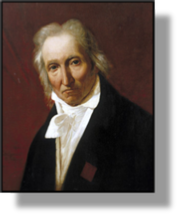 xxxxxJoseph Marie Jacquard was born in Lyon, the son of a
poor silk weaver. He assisted his father and, when he died,
inherited his two looms. He opened up a small weaving business, but
struggled to make a living. It was around 1790 that he began working
on an automated loom, but the French Revolution put paid to his
research. He fought on the side of the Revolutionaries, and it was
not until the turn of the century that he eventually came up with an
ingenious punched-card system which determined the order of the
threads in the warp. Patented in 1804,
this innovation proved so successful in the weaving of patterned
fabrics that on later machines he fitted the perforated cards into a
continuous loop. This provided a complete programme which not only
repeated the pattern, but could also be used over and over again.
xxxxxJoseph Marie Jacquard was born in Lyon, the son of a
poor silk weaver. He assisted his father and, when he died,
inherited his two looms. He opened up a small weaving business, but
struggled to make a living. It was around 1790 that he began working
on an automated loom, but the French Revolution put paid to his
research. He fought on the side of the Revolutionaries, and it was
not until the turn of the century that he eventually came up with an
ingenious punched-card system which determined the order of the
threads in the warp. Patented in 1804,
this innovation proved so successful in the weaving of patterned
fabrics that on later machines he fitted the perforated cards into a
continuous loop. This provided a complete programme which not only
repeated the pattern, but could also be used over and over again.
xxxxxThe Jacquard loom, the
basis of the modern automatic version, meant that weavers had no
longer to intervene in the production of a fabric once the pattern
had been planned and “punched out”. Furthermore, this automatic
control enabled the introduction of more intricate patterns, all
achieved accurately and at high speed. Not surprisingly this
invention was seen as a threat by the workers in the industry. In
Lyon and other centres, machines were smashed for fear of
unemployment. Nonetheless, within ten years over 11,000 such looms
were at work in France, and many were employed in other countries.
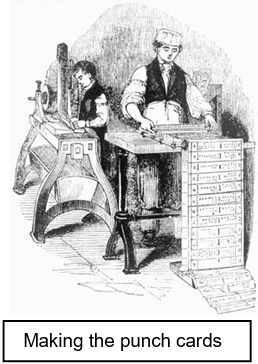
xxxxxJacquard did well
out of it. His loom impressed Napoleon and he was granted a state
pension as well as a royalty on each machine. Later, in 1819, he was
awarded a gold medal and the Cross of the Legion of Honour.
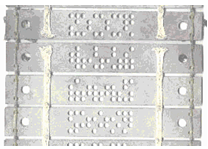 xxxxxThe use of punched cards (illustrated
here) was a break-through of some
significance. As we shall see, the English mathematician Charles
Babbage saw them working on one of Jacquard’s looms and used the
idea in the mid-1830s when he was working on what he called his
“Analytical Engine”, a mechanical device that proved the precursor
of the modern digital computer. He used the cards as a sort of
memory unit. Nothing much came of this idea at the time, but, in
fact, punched cards were used in the very early computers which came into use during the
1940s, and were developed further until largely replaced by
electronic devices some twenty years later.
xxxxxThe use of punched cards (illustrated
here) was a break-through of some
significance. As we shall see, the English mathematician Charles
Babbage saw them working on one of Jacquard’s looms and used the
idea in the mid-1830s when he was working on what he called his
“Analytical Engine”, a mechanical device that proved the precursor
of the modern digital computer. He used the cards as a sort of
memory unit. Nothing much came of this idea at the time, but, in
fact, punched cards were used in the very early computers which came into use during the
1940s, and were developed further until largely replaced by
electronic devices some twenty years later.
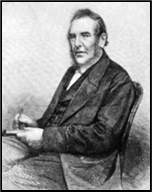
xxxxxMeanwhile, the method was
put to good use in some other areas. In about 1848, for example, the
Welsh engineer and tool-maker Richard Roberts (1789-1864)
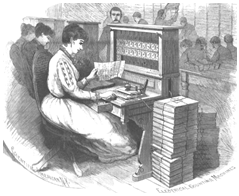 (illustrated) invented an
automated machine for putting holes in steel plates, using punched
cards to determine the size and pattern of the holes. Later, in the
United States, the statistician Herman
Hollerith (1860-1929) employed
perforated cards in a machine of his own making (illustrated) in order to sort out data from the 1890 census. The
analysis was achieved in less than half the time taken at the
previous census, conducted ten years earlier.
(illustrated) invented an
automated machine for putting holes in steel plates, using punched
cards to determine the size and pattern of the holes. Later, in the
United States, the statistician Herman
Hollerith (1860-1929) employed
perforated cards in a machine of his own making (illustrated) in order to sort out data from the 1890 census. The
analysis was achieved in less than half the time taken at the
previous census, conducted ten years earlier.
xxxxxIncidentally,
the first “Jacquard loom” - as noted above - was not
viewed kindly by his fellow weavers in Lyon. They smashed it up and
threatened Jacquard himself. He wrote at the time: "The iron was
sold for scrap iron, the wood for kindling, while I was delivered
over to universal ignominy”. But there was a happy ending. Later, in
1840, a statue was built in his memory, and erected on the very spot
where his revolutionary loom had been destroyed.
Acknowledgements
Jacquard: by the
French painter François Lepagnez (1828-1870), after an
original work by the French artist Claude Bonnefond (1796-1860)
– National Museum of Science and Industry, Science Museum, London.
Punch Cards: date and artist unknown. Roberts: drawing, date and artist unknown, contained in English and American Tool Builders by the
American engineer Joseph Wickham, first published in 1916. Card
Machine: artist unknown, contained in the
American scientific magazine Scientific
American, founded by the American inventor Rufus M.
Porter (1792-1884), and first published in 1845.
G3c-1802-1820-G3c-1802-1820-G3c-1802-1820-G3c-1802-1820-G3c-1802-1820-G3c






 xxxxxJoseph Marie Jacquard was born in Lyon, the son of a
poor silk weaver. He assisted his father and, when he died,
inherited his two looms. He opened up a small weaving business, but
struggled to make a living. It was around 1790 that he began working
on an automated loom, but the French Revolution put paid to his
research. He fought on the side of the Revolutionaries, and it was
not until the turn of the century that he eventually came up with an
ingenious punched-
xxxxxJoseph Marie Jacquard was born in Lyon, the son of a
poor silk weaver. He assisted his father and, when he died,
inherited his two looms. He opened up a small weaving business, but
struggled to make a living. It was around 1790 that he began working
on an automated loom, but the French Revolution put paid to his
research. He fought on the side of the Revolutionaries, and it was
not until the turn of the century that he eventually came up with an
ingenious punched-
 xxxxxThe use of punched cards (illustrated
here) was a break-
xxxxxThe use of punched cards (illustrated
here) was a break-
 (
(

